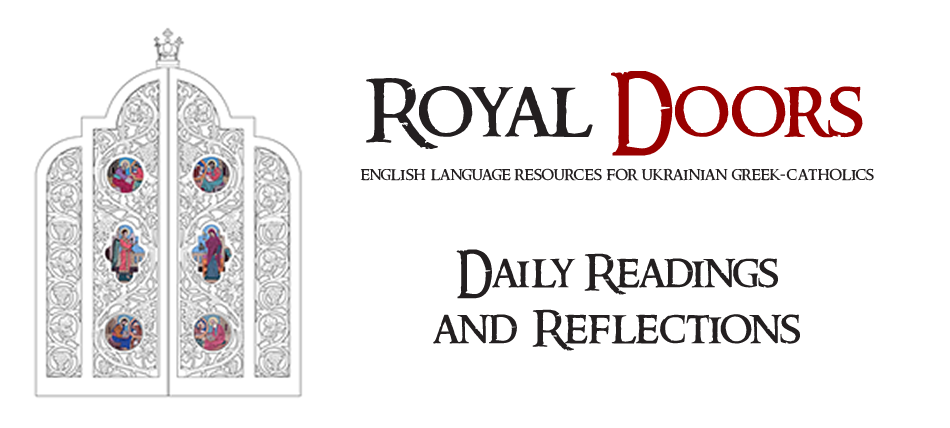by Brent Kostyniuk
As we all know, at the Last Supper, Jesus gave humanity the most precious gift it would ever receive, when He changed bread and wine into His Body and Blood. Since that time, those who follow Him have continuously heeded His exhortation to “…do this in memory of me” (Luke 22:19).
Jesus’ institution of the Holy Eucharist most likely came in the context of a traditional Passover meal. It recalls the night of the tenth and final plague when lamb’s blood was spread on doorframes to protect the Israelite’s firstborn children. According to custom, early in the Passover meal, the person presiding would take a matza, loaf of unleavened bread, and break it in two. Symbolically, unleavened bread was used because there had not been time to prepare leavened bread on that first Passover. The larger portion of the bread, the afikomen, was set aside, out of view. At the end of the meal, the afikomen was taken out of hiding, broken into smaller portions and distributed to each person present. The meal was eaten standing up, as if done in a hurry, and all of the food had to be consumed. When the afikomen had been eaten, a final prayer of thanksgiving was recited and a third cup of wine, the “cup of blessing” was passed around to all participants.
When the first Christians celebrated the Eucharist, they did so in imitation of the Last Supper. At about 55 AD, when St. Paul gave the first recorded description of a Eucharistic celebration in his first letter to the Corinthians. He tells us that Jesus asked His followers to break bread in remembrance of Him. Unfortunately, “remembrance” lacks the theological significance of the original Greek word anamnesis, meaning reminiscence or memorial sacrifice. By making the action a memorial, we are not passive onlookers, but become participants in the Paschal mystery.
Our use of the word Eucharist—eucharistia—meaning thanksgiving, also stems from Corinthians and was used to describe Jesus’ giving thanks at the Last Supper. By the late first or early second century, the word had been adopted to describe the ritual itself.
While Jesus used unleavened bread at the Last Supper, both leavened or unleavened bread have been used through the ages. For the Jews, unleavened bread was known as “bread of affliction.” However, since early Christians wanted to joyfully commemorate Jesus’ Resurrection, they chose leavened bread as more meaningful.
Today, in some Eastern Catholic traditions, including the Byzantine, leavened bread continues to be used, as a symbol of the Risen Christ. A round loaf called prosphora—Greek for offering—is baked from flour and water, along with a small amount of salt [in some traditions] and yeast. Whether leavened or not, Eucharistic bread must be made from wheat flour only and natural water. Traditionally, the prosphora is baked weekly by the priest, although in large, modern parishes the task often falls to nuns or even the laity. After the loaf has been shaped, it is stamped with an image generally marked with the Greek letters IC—abbreviation for Jesus—XC—Christ, and NIKA—Conquers. In some traditions, five small loaves are used, symbolic of the five loaves used to feed the 5000.
The prosphora is brought to church and in preparation for the Divine Liturgy, where the priest, and deacon if present, perform the Proskomedia rite at the altar of prothesis, a small table of preparation to the left of the main altar. This highly symbolic action recalls the Passion. After blessing the loaf, the priest takes a small knife known as the Holy Lance and makes an incision into the right side of the seal saying, “As a sheep, He was led to the slaughter.” Along the left side of the seal he cuts and says, “As a spotless lamb before its shearer, He opens not His mouth.” The action is repeated at the top with the words, “In His humiliation, His judgments were taken away,” and the bottom with, “And who shall declare His generation?” Lifting out the holy bread he says, “For His life is taken from the earth.” He cuts it in the form of a cross saying, “The lamb of God Who takes away the sin of the world is sacrificed for the life and salvation of the world.” Finally piercing the right side with the lance, he says, “One of the soldiers with a lance pierced His side and immediately there came out blood and water. And he who saw it has given testimony, and his testimony is true.” The resulting portion of bread known as the Lamb is placed on the diskos—paten—to be consecrated during the Divine Liturgy. Additional smaller particles are arranged on the diskos to represent the Theotokos, saints, and both the living and the dead whom the priest intends to commemorate. He concludes with a particle for himself. The remainder of the loaf not used in the consecration, the antidoron, is set aside and distributed at the end of the liturgy.
In the West, round wafers known as hosts—Latin hostia—meaning victim or one to be sacrificed, are used. Hosts are made by pouring a flour and water batter onto a hot griddle with upper and lower plates, similar to a waffle iron. It is cooked for a short time, then allowed to cool. Engraved plates are used to make embossed hosts. The large sheets of bread are then cut into individual hosts with a device similar to a paper hole puncher. While unleavened bread does store well, hosts are required to be recently made. Indeed, in Rome bakers of altar breads must swear the hosts they sell are not more than 15 days old.
East or West, leavened or unleavened, bread, through the consecration, becomes essential for our spiritual well-being.
In the form of bread so lowly, by example You do teach, to help others in misfortune, thus all burdens to relieve. – Here Among Us, My Dear Saviour
This piece first appeared in The Prairie Messenger. Reprinted with permission.

